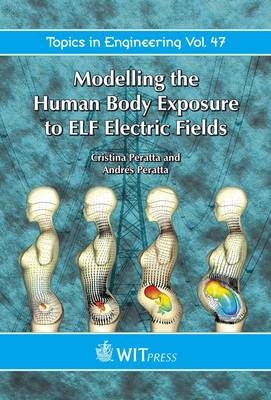
Modelling the Human Body Exposure to ELF Electric Fields
WIT Press (Verlag)
978-1-84564-418-5 (ISBN)
- Titel ist leider vergriffen;
keine Neuauflage - Artikel merken
Cristina PERATTA her MSc in Physics in 1996 from the University of Buenos Aires (Faculty of Exact and Natural Sciences), Argentina and her PhD in 2008 from the Wessex Institute of Technology- University of Wales, UK. Her background is in Numerical Modelling applied to Electromagnetic problems. She developed her thesis at the Plasma Physics Institute, (INFIP), University of Buenos Aires-CONICET, Argentina, in numerical modeling applied to Nuclear Fusion in Z-pinch experiments. In December 2007 Cristina was employed by BEASY, where she has been applying her knowledge and the BEASY software to specific customer consultancy and development projects, primarily in the field of corrosion simulation. Cristina has been author or co-author of more than 15 specialized publications in international peer-reviewed journals and transactions. Her research interests are oriented to numerical modeling of electromagnetic fields, boundary and finite element methods, corrosion, cathodic protection systems and electrochemical processes, as well as electromagnetic modeling in biological tissues. Andres PERATTA received his MSc in Physics in 2001 from the University of Buenos Aires, Argentina, and his PhD in 2004 from the Wessex Institute of Technology (WIT) - University of Wales, UK. During 2005 he was a Postdoctoral Fellow and Lecturer at the Wessex Institute of Technology, Southampton, UK, and became a member of the Editorial Board of the Journal of Communications, Software and Systems (JCOMSS) sponsored by the IEEE and SoftCom Society. In 2006 he became Head of the ICE Division at Wessex Institute of Technology and ISAC member of the WIT International Conferences on Environmental Electromagnetic Compatibility, Simulation of Electrochemical Processes, and Computational Ballistics. Andres has been author or co-author of more than 40 specialized publications in international peer-reviewed journals and transactions. His research interests are Numerical Modelling including Boundary and Finite Element methods for Electromagnetic Fields, Fluid Dynamics and Continuum Mechanics. He has participated in several internationally funded research projects involving modelling of fluid flow in porous media, corrosion, cathodic protection systems and electrochemical processes, as well as electromagnetic modelling in biological tissues.
Chapter 1: Introduction Extremely low frequency exposure; Computational dosimetry at ELF Chapter 2: ELF Electromagnetic exposure Introduction; EM exposure. Basic concepts; Theoretical model for ELF; Different sources of exposure at ELF; Summary Chapter 3: Dielectric properties of biological tissues Introduction; Modelling biological systems; Available data on dielectric properties; Theoretical aspects. Biological matter in electric field; General dielectric properties of some tissues; Biological tissue at ELF; Summary Chapter 4: Numerical method Introduction; Integral formulation; Boundary discretisation; Internal solution; Continuous and discontinuous boundary element method; Staggered boundary element; Analytical approach for the integrals; Accuracy tests; Summary Chapter 5: Exposure to overhead power lines Introduction; Physical model; Human body modelling; Numerical implementation. Extreme and minimal domain decomposition; Global results; Analysis of the refinement of geometry; Analysis of variations on conductivity; Summary Chapter 6: Exposure in power substations rooms Introduction; Induced currents in the human body inside a power substation room; Induced currents in the human body resulting from the proximity to surfaces at fixed potentials; Summary Chapter 7: Pregnant woman Introduction; Physical model; BEM for vertically incident field in open environments; Numerical implementation; Results and discussion; Summary Chapter 8: Conclusions Concluding remarks
| Erscheint lt. Verlag | 30.9.2009 |
|---|---|
| Zusatzinfo | Illustrations |
| Verlagsort | Southampton |
| Sprache | englisch |
| Maße | 165 x 242 mm |
| Themenwelt | Studium ► 1. Studienabschnitt (Vorklinik) ► Physiologie |
| Naturwissenschaften ► Physik / Astronomie ► Angewandte Physik | |
| ISBN-10 | 1-84564-418-2 / 1845644182 |
| ISBN-13 | 978-1-84564-418-5 / 9781845644185 |
| Zustand | Neuware |
| Haben Sie eine Frage zum Produkt? |
aus dem Bereich


